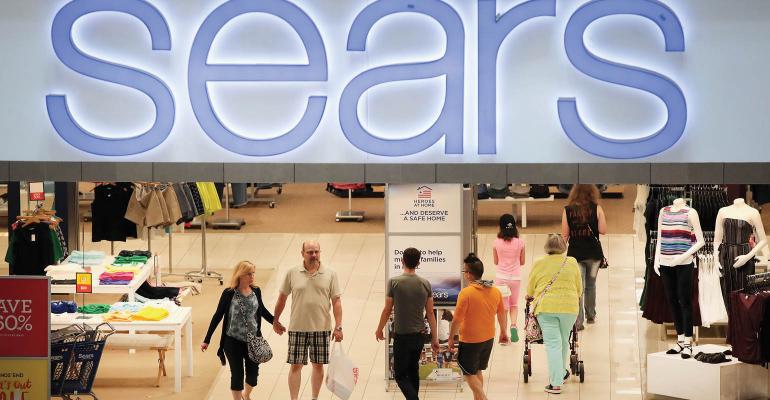Sears may not be dead just yet. But a Hail Mary effort to keep the retailer in business remains a long shot.
On Tuesday, a bankruptcy judge granted Sears Chairman Eddie Lampert a last-minute reprieve in his bid to keep the company in business. Lampert wants to purchase the 425 stores out of bankruptcy and preserve up to 50,000 jobs through his hedge fund ESL Investments. Sears Holdings Corp., which owns Sears and Kmart stores, had rejected Lampert’s $4.4 proposed bid.
The judge granted ESL until 4 p.m. today to come up with a $120 million deposit and Sears will allow Lampert to take part in a bankruptcy auction scheduled for Monday, January 14. However, Reuters reported that Sears has chosen a liquidator–New Jersey-based Abacus Advisory Group LLC–in case that bid fails.
The struggling chain filed for Chapter 11 bankruptcy protection in October after years of declining sales. At the time, it operated roughly 700 Sears and Kmart stores and employed 68,000 people. It had already announced the closing of 143 underperforming stores by the end of 2018, and then in November announced another 40 stores will be shuttered in February. And last month, it revealed 80 more stores that will close in March.
What are chances of Sears’ success?
Lampert has said if his bid is approved, he would rework the company to focus on a “right-sized network” of stores, digital assets and interdependent operating businesses.
“Lampert now seems to accept that Sears needs to be shrunk,” says Neil Saunders, managing director at research firm GlobalData Retail. However, he still maintains that it can be transformed into a profitable operation.
“In my view, I see little evidence that such a transformation will be successful,” Saunders says. “The company is still losing customers and losses are mounting. The business is just not sustainable.”
Saunders believes liquidation is the best strategy. “Assets can then be used to pay down debt and space can be exited and transferred to retailers that are more productive and profitable,” he says.
Saunders notes that data from the holidays shows that overall customer usage of both Sears and Kmart has fallen, and “perceptions of both brands are down on last year's low scores. In our opinion, this is a brand now at rock bottom,” he states.
Ultimately, Saunders wouldn’t rule out that brand assets could be purchased during liquidation, with the Sears name possibly surviving as an online-only entity. He describes this outcome as a “dispiriting end to a once-iconic retailer.”
Sears is ‘irrelevant’
“Sears remains irrelevant, and Lampert has proven year after year that he does not have a working strategy to improve performance,” says David Weiss, a partner at Chicago-based consulting firm McMillan Doolittle.
Weiss says he visited what was likely the last “new” store opened by Sears, which was a remodel at Oakbrook Center in Oak Brook, Ill., and presumably Lampert’s model of the future.
“It was clean. It was new, but the layout was a hodgepodge of many indefensible categories,” Weiss says. “There’s a large amount of square footage allocated to mattresses at a time when there are mattress retailers on every suburban corner and a growing acceptance of buying from disruptive mattress retailers. Fitness equipment is adjacent to jewelry. It just doesn’t make any sense from a retailer’s strategy.”
A comeback would be challenging
There could be an opportunity for a slimmed-down Sears to be successful, “if they play to their strengths of brand loyalty in a selected few categories,” says Rachel Elias Wein, president of WeinPlus, a St. Petersburg, Fla.-based strategy and management consulting firm.
The challenge is that many of their most respected internal brands, like Craftsman and Kenmore, were already sold or in limbo, Elias Wein says.
“The opportunity for Sears' resurrection gets harder and harder as the core of the business—the premier brands in great locations—has been diminished by asset sales,” Elias Wein says.
Opportunity to backfill, redevelop with more relevant uses
Elias Wein says Sears has historically owned some of the very best retail real estate. However, she says much of that value has already been extracted in the Seritage Growth Properties portfolio, with roughly 250 Sears and Kmart locations having a “three-year head start on redevelopment.”
In 2015, Lampert spun out 250 of the company’s top properties into the Seritage REIT.
“Surely, there's value in the remaining portfolio and that will be an opportunity for traditional big-box retailers as well as grocery retailers testing mall-based locations,” Elias Wein says.
In many cases, due to frontage needs and size constraints, she says the most economical option will be to demolish the existing box and replace it with either alternative big-box retail uses or non-retail uses like office and residential.
In December, Sears hired commercial real estate firm JLL to gauge interest in Sears’ real estate portfolio to determine if it’s worth more sold off in pieces. Burlington Stores, At Home Group, Dick’s Sporting Goods and U-Haul have shown interest in acquiring some Sears and Kmart locations, Bloomberg reported. Also, some buyers are interested in demolishing stores and repurposing the sites into uses like office or residential.

